Avenel Heritage and Nature Trail

Avenel township was first established at Hughes Creek crossing on the Melbourne-Sydney Rd around 1838. With the discovery of gold to the north, traffic increased substantially. The township became a significant way point for travellers. The crossing was bridged and Cobb & Co coaches used the nearby Royal Mail Hotel (1847) as a staging post. This historic building is just one example of many you will visit on your walk.
Increasing passing traffic and an expanding primary industry soon attracted business and residents to the town. As a result, historic architecture is an enduring feature. Construction of the railway station (1872) created new opportunities 1.5km from the town origins. Along with other newcomers, Ned Kelly's family moved here in his youth.
This has been Taungurung country for thousands of years. Stewart Park provides an opportunity to connect with that past and to appreciate an environment of pristine waterways, bountiful bush and magnificent river red gum woodland.
This is an integrated trail and you can choose to walk it all, design your own or follow trail markers within it for shorter options. Comprehensive information signs are in place at numerous locations. You can pick any point at which to begin. Car parking is readily available throughout.
For the full 5.5km walk, a recommended starting point is near Hughes Creek crossing, where the town began. Park at the corner of Mitchell St and Scobie Street South.
Map of Route

Interactive Map
Points of Interest
1. Informative trail signage
Throughout this trail, comprehensive signage and maps inform walkers about significant points of interest. The trail of informative signs begins here, including maps and Ned Kelly Trail markers.
2. Royal Mail Hotel
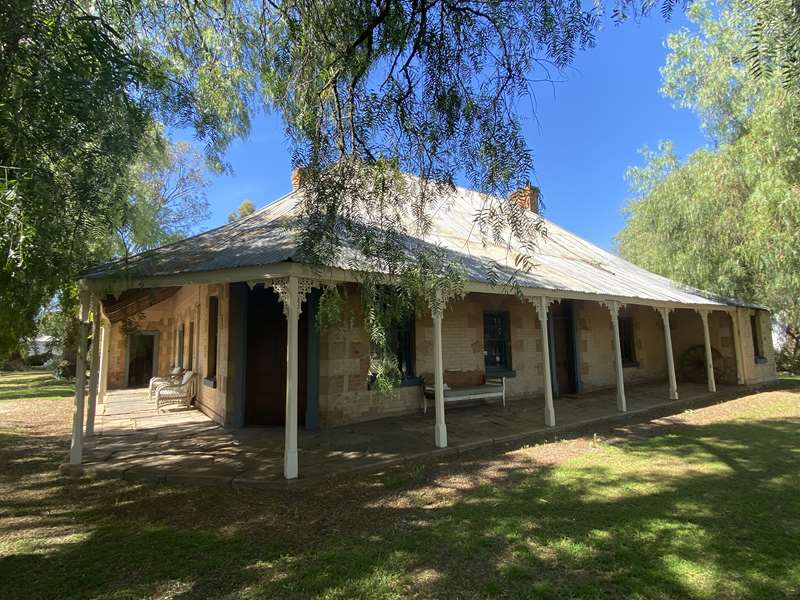
Built in 1847, this was the site of the original Cobb and Co staging post above Hughes Creek. Note, this is now a private residence.
In the 1860s the Shelton family owned and operated the Royal Mail Hotel for travellers en route to the goldfields. Their seven year old son Richard was rescued by Ned Kelly when he almost drowned in the Hughes Creek nearby. In recognition of his bravery the Shelton family presented Ned with a green, gold fringed silk sash 7 feet long and 5 inches wide. The colour is emblematic of Irish heritage. Ned wore the sash under his armour in the Kelly's last stand at Glenrowan and it is now on display at the Benalla Costume and Pioneer Museum.
3. Hughes Creek Bridge
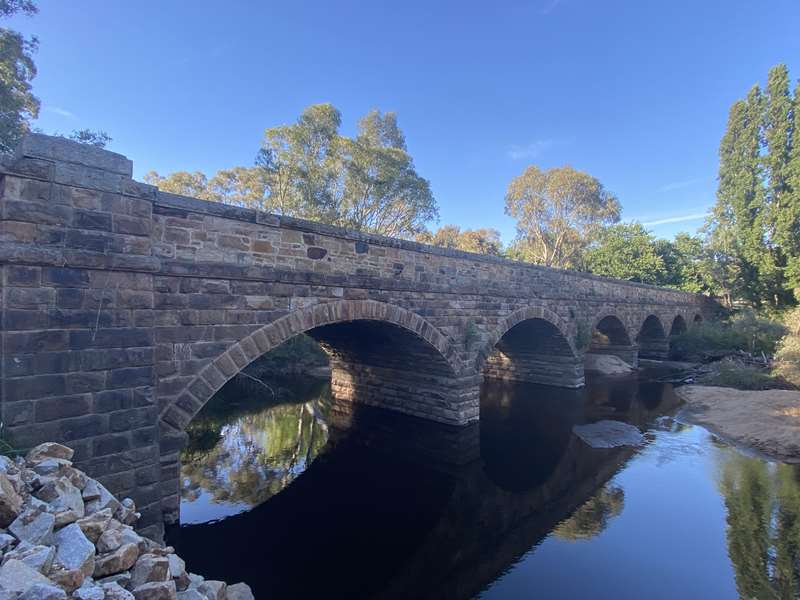
As traffic to the goldfields and between Melbourne and Sydney put more pressure on the road, this historic six arched sandstone bridge replaced a small wooden bridge built in 1817. After the bridge was completed in 1869, a toll-gate was erected on the south side along with a small wooden cottage for the toll keeper. This bridge is a fine example of 19th century construction and stands as a monument to the early stonemasons and road engineers of Victoria.
Approximately 150 metres downstream is the site where Ned Kelly rescued Richard Shelton. Richard accidently fell from a makeshift foot bridge into the high flowing Hughes Creek on his way to school.
In the early days, travellers would cross the creek and camp in Stewart Park (opposite side of the road -north side of the bridge), some moving on, others staying until they found work or accommodation. There are still Aboriginal scar trees along the creek; evidence of their activity in the area that was still reported in the 1860's. Ned Kelly may well have been exposed to the skills of the aboriginals who camped near town. Ned developed a great respect for the aboriginals and their skills as 'trackers'.
There is a BBQ under a shelter and table under trees near the bridge.
4. Stewart Park Nature Trail

Natural world beauty in the shape of a creekside trail under magnificent river red gums. What more could a walker want? Keep on walking to find out.
5. Jubilee Park
Car parking, picnic tables, BBQs, playground, pool, potable water, public toilets, tennis courts, historic features, gardens with leafy, sheltering trees. Local parks don't get much better than this.
6. Historic courthouse and police residence

Maintained in beautiful condition, these historic buildings sit proudly on the corner looking as good as they ever did. The police residence is now Avenel Neighbourhood House.
The former Avenel Court House was erected in 1876 by the Public Works Department on land previously set aside as a police paddock. The design of the building was prepared by H.A. Williams, the Public Works Department architect for the North-Eastern area. The contractor was J. Hilet - a local businessman. The building is a typical example of mid-nineteenth century provincial court house design, with its simple gabled form expressing the main court room, flanking offices and verandah across the entrance facade. The simple decoration around the gable and verandah enhances the building's form and is a notable feature.
The court was a busy place, meeting monthly and dealing with mostly small disputes, petty crime, civil matters and inquests. The magistrates were actually Justices of the Peace appointed by the Attorney General from the ranks comprised of local notable people. The prosecution of cases was the responsibility of local police a practice that continues to this day. The business conducted was summarised in the widely distributed local Seymour newspaper as the "Avenel Mems".
The lockup was situated at the rear of the Police Residence. The original Police Station and lockup in Ash Street, where Ned Kelly's father Red was once tried and incarcerated, is long gone. In 1969 the Police office was demolished; the residence fell into disuse and official police duties were conducted from Seymour and Nagambie. Court proceedings likewise, were shifted to Seymour. Subsequent to the removal of official legal business, the building has been available for community activities and houses a display of historical information.
7. A cluster of churches
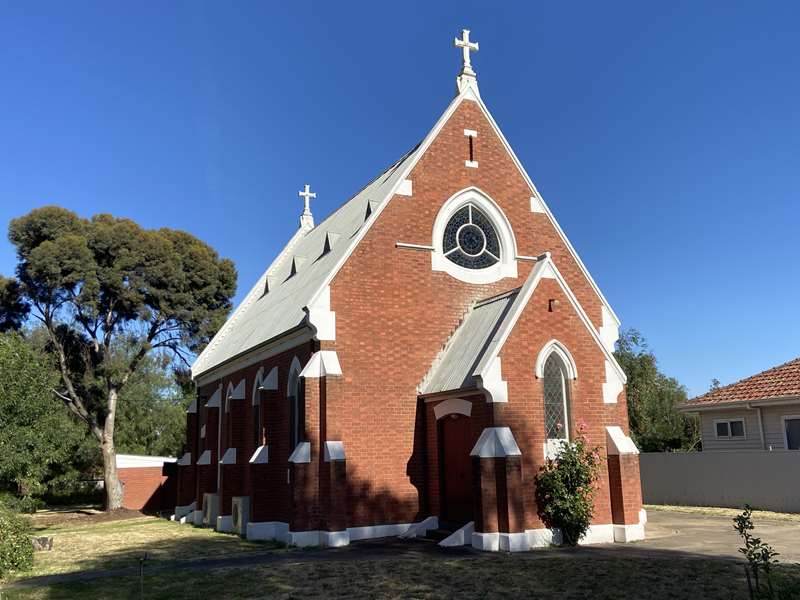
Three historic churches gather at this location to stand testament to the craftsmanship of days gone by. They are the Avenel - Nagambie Uniting Church, St Marys Catholic Church Avenel and St Paul's Church Avenel.
8. Historic Post Office
A General Practice and Pharmacy that provides food service now operate here. This attractive building would have some fascinating stories to tell as everyone in and outside town passed through.
The township of Avenel was established in 1849, ten years after the first Overland Mail Service from Sydney to Melbourne was established. The township grew around the mail route; along what is now Mitchell Street; and so the demand for postal services grew. William Campion opened Avenel's first Post office on June 2, 1858. It was a wooden structure on Mitchell Street, right in the centre of what has become now known as "the Old Town". Campion was an enterprising gentleman, also running a store and a library on the site.
Relics of this store no longer remain but there is a disused stone-fronted dwelling known as "the Campion house" next to where the store was located.
The coming of the railway in 1872 drew business activity away from Mitchell Street. The area adjacent to the station became the new hub known as "the New Town". Accordingly, petitions were made to move the post office closer to the new commercial hub and it was relocated to a cottage in Murchison Road, just by the railway crossing. This cottage still exists today. After a great deal of lobbying to the Post Master General by the community, postal services were finally moved to the newly completed imposing brick structure Queen Street in c1900. It had been built to "standard PMG specifications" and included a manual telephone exchange. This manual telephone exchange, and it's incumbent "party line" operated until the late 1960's, forming an integral part of the district's social history (and probably creating a lot of it as news travelled up and down the party line very readily!)
The old telegraph line still exists alongside the railway line today. This original brick building although in good repair was sold off in line with an Australia Post business strategy and at Avenel postal services were relocated to the general store opposite in 2001.
9. Site of the original General Store

A perfect setting for browsing antiques, the W. B. Gadd building oozes character.
10. Avenel Railway Station
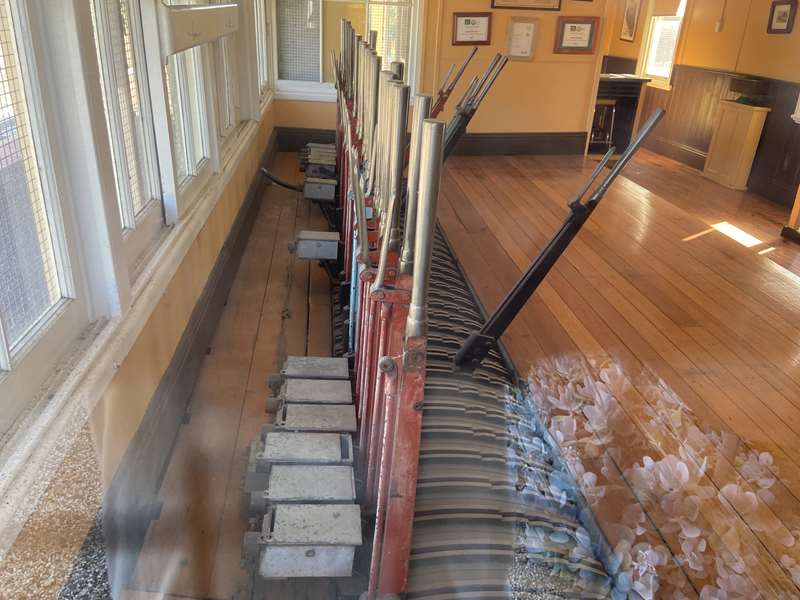
The volunteer group that cares for this station do themselves proud. Lovely gardens, public art and a restored station house including a complete McKenzie - Holland Signal Lever Frame!
Avenel railway station opened on 20 November 1872. Following a protracted ten-year process of construction of the North Fast line from Essendon to Seymour, the second section in the line from Seymour to Benalla was completed by 31st December 1872, a much shorter 20-month timespan.
Following torrential rains in 1870, major civil engineering works were required to all river crossings on the original line plan, including Hughes Creek at Avenel. This required a wrought iron bridge with nine 20-foot spans.
The original station opened with a 200 foot (61 metres) long platform, temporary station buildings and a large goods shed. A permanent station building was provided in 1881, which was replaced in the 1970's.
Following the opening of the station yard at Avenel it became a hive of activity as a lot of the produce from the Goulburn Valley and horses, cattle and sheep were brought overland to Avenel for rail to the Melbourne markets.
This traffic ceased after 1880 due to the opening of the Mangalore/Shepparton line, but firewood and sawn timber took over the major outward traffic as farm lands were cleared of trees. Up to four sawmills were known to have operated in the Avenel goods yard.
The station building and it's attached residence lasted intact until the coming of the standard gauge line, when the residence was removed. Another residence (the gate-keeper's cottage) near the up-end of the platform has been removed The domed goods shed at the north end of the station was sold and removed during the 1970's and the remaining goods shed was dismantled sometime in the 1980's.
In the early days, the railway station provided the growing town with a link to the outside world, bringing mail, newspapers, goods, people and racehorses with jockeys! (Avenel racecourse was a major Victorian country track up until the 1940's.) The station remains a vital transport link between Melbourne, Sydney and many country towns in between.
A dedicated group of residents, known as the "Stationeers" meet on a Friday morning to tend the Avenel station award-winning gardens which are a delight to residents, rail passengers and visitors alike. The Stationeers are also responsible for the refurbishment of the station building which includes a McKenzie & Holland lever frame mechanical signal control.
11. Harvest Home Hotel

If you want to experience the ambience of a fine mid 19th century hotel, this is the place to go. Renovated with remarkable attention to detail, this is a captivating building inside and out.
12. Avenel Cemetery
The lawn cemetery section features an explosion of colour in plastic flowers.
The Avenel Cemetery was established in 1863, enclosed by, a picket fence and a line of rose bushes to the north east. It was extended in 1895 and contains 620 graves of which many are unknown or unmarked.
In 1988 a lawn section was developed off Queen Street and was followed soon afterwards, by the establishment of the Memorial Wall and a Rose Garden.
However, the first cemetery in the district was established 4km south of the Avenel township where 3 headstones remain dating from 1854. This is now on private property.
Some persons of interest laid to rest in the Avenel cemetery include Arthur Bayley the discoverer of gold at Coolgardie WA. Having made his fortune he bought "Avenel Estate" a grazing property located on the Hughes Creek. An imposing memorial to his deeds remains. The Robertson family were early settlers in the district. Their daughter, Sarah Ann, was born in 1854 and she was one of the first white children born at Avenel. Also resting here are some who served in the A.I.F. and some Chinese who worked on the Victorian goldfields.
13. Red Kelly's grave
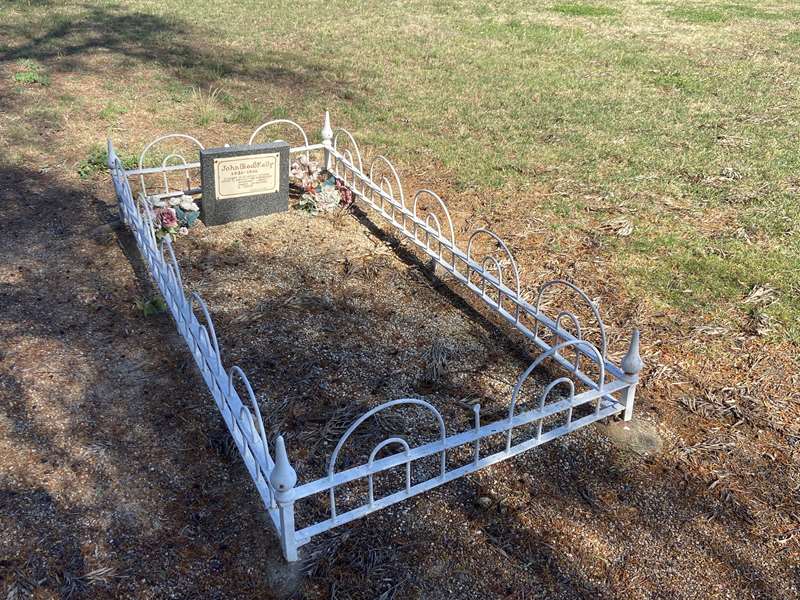
The most visited memorial in the Avenel Cemetery is that of John 'Red' Kelly, the father of Ned. The Kellys lived at Avenel from 1864-1867 'Red' died in 1866 aged 45. Ned Kelly's father died when Ned was just 11. He was said to have died of "dropsy." Young Ned reported the death to the authorities. The Avenel Historical Society erected a memorial to him.
Ned Kelly's father, John 'Red' Kelly, was laid to rest in the cemetery on 28 December 1866. Red had arrived in Van Diemen's Land in 1842 having been sentenced in Ireland to seven years transportation. During his time in Avenel Red was found guilty of 'having illegally in his possession one cow hide'. This was the result of a desperate attempt to provide food for the young family. When he returned from the police lock up he was soon charged with being drunk and disorderly. Red died 16 months later, a victim of 'the drink'.
The following day Ned reported his father's death by providing the details as required by law and he signed the register with 'Edward Kelly, Son'. Red had few successes in his life. He was a criminal, an unsuccessful farmer and land speculator, and was barely able to provide for his family. Despite this he was loved by his wife and seven children up until his death at the early age of 45.
14. Great War Memorial
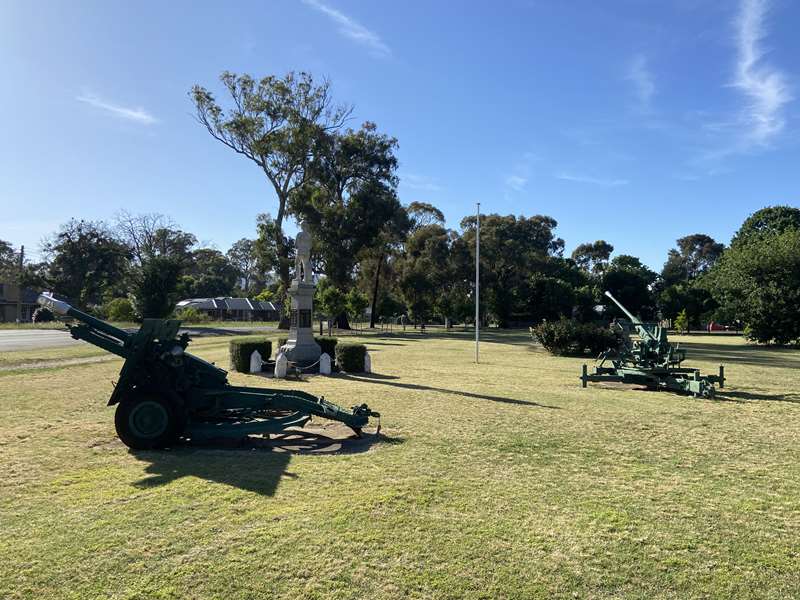
Pay your respects to Avenel's war dead in a well kept garden featuring an upstanding monument and pristine guns. Take some time feel the power of the setting and consider its significance.
This area also has a water tap with plaque which was unveiled in 1987 commemorating the opening of the treated water supply from Seymour to Avenel. There is also a time capsule to be opened in 2038.
15. Attractive historic dwellings are spread throughout the town
Well presented homes with lovely gardens adorn Avenel streets. Many more than a century old are still looking grand. Proud locals tend their gardens regularly, attracting compliments from passers by.
16. Original Teacher's residence

Avenel School (No. 8) is significant in its own right. With the original Teacher's residence still standing next door, it is of even more interest. Occupants of this homely cottage had a short commute.
17. Hidden history
At this location above Stewart Park, an oak was planted to commemorate the then Princess Elizabeth's 2 1st birthday. The oak has grown to obscure two other historic markers on this site. Seek them out. Can you find the solitary grave of Morris Levy (1854), drowned in the creek below? What are the other two features (from 1924 and 1947)?
18. Cultural and Environmental Education
Return to Stewart Park via the entrance opposite the Avenel Pub. The picnic areas here include roofed interpretive signs with fascinating historic and environmental information. The images are a treat. After reading, you will want to stay longer, explore further and enrich yourself in this ancient place.
Head toward the bridge again to pass under and return to your point of origin.
Access for Dogs:
Dogs are permitted on leash.
Photos:
Location
20 Scobie Street South, Avenel 3664 View Map
Web Links
→ Avenel Heritage and Nature Trail (Walking Maps)
→ Avenel Heritage and Nature Trail Brochure (PDF)








